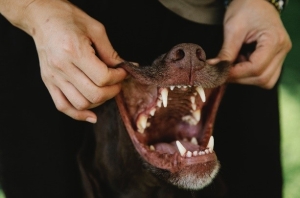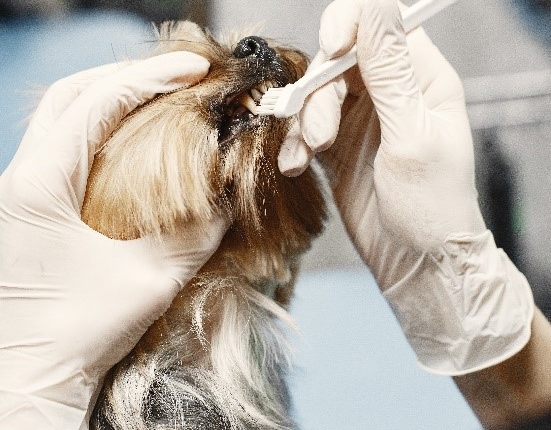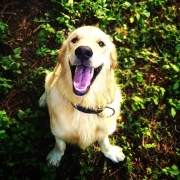A big thank you to BarknBig for guest writing this blog, as part of our monthly Business Partner Program. BarknBig manufactures premium canine treats and chews, and is located in Loveland, CO. They can be reached at Barknbig.com and (970) 663-4561.
It’s hard to look at a smiling dog without smiling ourselves. Their bright eyes, wet noses, and an uncanny ability to swindle a bit of free lovin’ from everyone they meet are just a few of the reasons why we love our dogs – and most other people’s dogs too!
While few people comment on a dog’s beautiful smile, healthy teeth and gums are an important part of every dog’s life – dogs use their teeth every day, after all. Beyond contributing to a dog’s overall wellbeing and quality of life, you will enjoy the absence of bad breath that can be downright offensive.
What Contributes to Poor Dental Health in Pets?
Most pet owners understand that not brushing their pet’s teeth or getting dental check-ups are direct contributors to poor dental health. But there are other, sometimes unusual incidents that can also play a role. Take our dog, Guthrie. He is a 25-lb. Basenji with a TON of energy whose favorite thing in life – next to getting treats – is playing with his Kong toy.
We have a raised patio in our back yard. Guthrie uses the patio as a launch pad to catch Kongs on the fly. Kongs come in different sizes, and the larger ones are heavier – apparently heavy enough to loosen poor Guthrie’s teeth. We noticed that Guthrie wasn’t even trying to pick up the Kong when it was on the ground….VERY unusual! We eventually put two and two together to figure out that the large, heavy Kong was too much trauma for his young teeth. We switched to a smaller Kong and gave his teeth time to heal. He couldn’t be happier.
Aside from losing a tooth, do you know what else can be painful for dogs? A chipped or cracked tooth. Some dogs chew rocks – why, I have no idea – but rocks can break dogs’ teeth. Most tooth fractures occur when dogs chew on objects that are too hard, like ice cubes, bones, hard nylon chews, antlers, and horse or pig hooves. Sometimes an accident can chip or cause a hairline crack to a dog’s tooth. When a dog’s tooth is hurting, you’ll notice a decreased interest in eating their food or chewing on tough things like bully sticks or bones.

For a chipped or fractured tooth, seek veterinarian care. When a chipped tooth exposes the pulp (which is where nerves and blood vessels are), not only can that be painful for your pup, but it’s not going to heal itself. Leaving the tooth untreated can allow bacteria to enter areas of your dog’s mouth that can lead to a more serious infection, especially down the road as your pup ages and age-related eating issues can start.
People vs. Dogs – Dental Health is Different
Dogs and people experience some of the same oral diseases. Whereas the most common dental disease in people is tooth decay or cavities, tooth decay in dogs is rare – representing less than 10% of all dental problems.
The most common dental problems seen in dogs are fractured teeth and periodontal disease. We talked about fractured teeth above, so now we’ll switch gears to talk about periodontal disease.
It is estimated that more than two-thirds of dogs over three years of age experience some degree of periodontal disease, making it the most common ailment affecting people’s dogs. Gingivitis (inflamed gums due to plaque and tartar build-up) is the first stage of periodontal disease and is the only truly reversible stage.
Untreated dental disease can lead to painful abscesses or other infections that can spread throughout your dog’s body. In extreme cases, it can lead to permanent jaw damage and even heart disease. As with people, heart disease can shorten your Best Friend’s lifespan.
How to Maintain Your Dog’s Dental Health

Teeth are a tool. Much like shop tools and garden tools that work better and last longer when they’re periodically cleaned, dogs’ teeth also need to be cleaned, at least occasionally (and more often if you can convince your dog to be a willing participant).
Bad breath and tooth loss are early indicators that your dog’s dental health needs some attention. I don’t know if dogs mind when their breath stinks – it sure doesn’t seem like it – but their owners, other family members, and guests most certainly notice bad breath. Think about your poor pup, especially if they have lost a tooth or two. Daily pain often precedes tooth loss. Because of the pain, your dog may avoid eating which is definitely not good.
Beginning with the easiest and least expensive option and progressing to professional cleanings by a veterinarian, below are suggestions about things you can do to help keep your pets’ dental health in tip-top shape.
- Water Additives / Powders to Add to Food / Topical Sprays & Gels – As with small children and medicine, it’s easier to get them to take it if you’re able to sneak it into juice or something else that they like. There are a number of products on the market that have been shown to reduce the accumulation of plaque/tartar build-up on pets’ teeth and have therefore been accepted by the Veterinarian Oral Health Council (VOHC.org) to assist pet parents with their dogs’ and cats’ dental health. Water additives and powders that can be sprinkled on your pet’s food will likely be the least offensive approaches, at least in your pet’s opinion. The key is consistency. By using these products regularly, they are able to effectively do their job and will hopefully eliminate the need for more hands-on approaches. If you are a cat and dog household, there are options where the same product can be given to both felines and canines.
- Dog Treats & Chews – Whether online or found at local retailers, hundreds of different types of dog treats and chews are readily available. You can find dog treats that have been formulated to specifically remove plaque buildup and often contain ingredients that freshen breath and will clean your dog’s mouth. When it comes to dog chews, almost all of them have teeth-cleaning properties. The act of gnawing on dog chews helps scrape plaque off dogs’ teeth. Chews also contribute to brain stimulation and help to relieve boredom. Look for 100% natural chews (such as com’s bones, bully sticks, tendons, and antler sheds) which contain health-promoting substances like glucosamine, hyaluronic acid, chondroitin, and other minerals.
- Tooth Wipes / Toothbrushes & Toothpaste – While not as passive as water additives or powders, there are at-home wipes and toothpastes that have been formulated specifically for dogs – in flavors like chicken and peanut butter to lessen their resistance. Keep in mind, however, that wipes are more of a surface cleaning option designed to freshen breath and won’t get into the crevices between teeth the way a toothbrush will. Note to self: cats DON’T DO wipes or toothbrushes!
- Professional Cleaning – The best way to clean and maintain your dog’s oral health is to schedule a professional cleaning with your veterinarian. This is the most expensive option – usually several hundred dollars – since it requires anesthetizing your dog during the procedure and, in some instances, requires pre-op blood tests, but this approach also allows your veterinarian to prevent, locate, and treat any issues that could go unnoticed by dog parents, simply because our pups can’t always tell us when something is wrong. Professional cleanings are more common with certain breeds because they are necessary. Because of the sedation aspect, the risks to your pup can be higher as they get up in years. Your veterinarian can discuss the risks and benefits with you based on the breed and age of your pup and can advise if one of the lesser options mentioned above can serve as a suitable alternative.
Owning pets is a big responsibility and a beautiful gift that you give yourself. Oral health is an important part of pet ownership. Fortunately, most dental disease is preventable with regular, at-home care and occasional professional dental cleanings.





